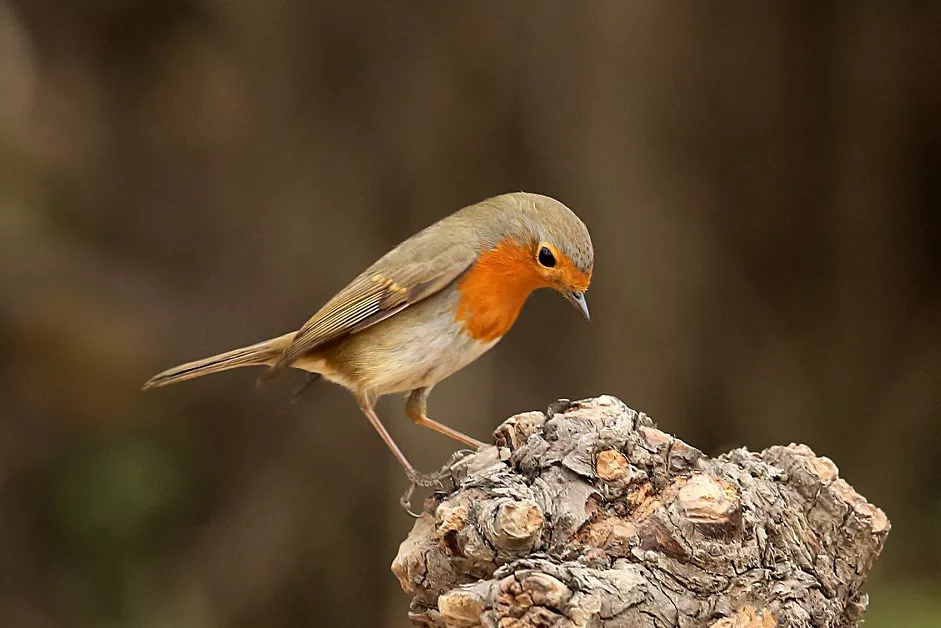The European robin (Erithacus rubecula), often referred to as the robin redbreast, is a beloved and iconic songbird that holds a special place in the hearts of many. Renowned for its distinctive appearance, melodic song, and close association with folklore and symbolism, the European robin is a cherished bird species found throughout Europe. In this article, we will explore the characteristics, habitat, behavior, and cultural significance of the European robin, shedding light on its remarkable attributes and captivating allure.
Physical Characteristics:
The European robin is a small bird, measuring approximately 12-14 centimeters in length. It is known for its plump body, rounded wings, and relatively long legs. The most striking feature of the robin is its vibrant orange-red breast, contrasting with its brownish-gray upperparts and white belly. Both males and females possess this characteristic coloration, although the male’s breast may be slightly brighter during the breeding season. Additionally, the European robin is distinguished by its large, dark eyes and a small, pointed beak that aids in its foraging activities.
Habitat and Distribution:
The European robin is widely distributed across Europe, ranging from the British Isles in the west to the Ural Mountains in the east. It is also found in parts of North Africa and the Middle East. This adaptable bird can thrive in various habitats, including woodlands, gardens, parks, hedgerows, and even urban areas. It is particularly associated with areas where shrubs and low vegetation provide suitable nesting and foraging sites.
Behavior and Song:
European robins are known for their territorial behavior, with males fiercely defending their nesting territories during the breeding season. They are solitary birds outside of the breeding season and are known to migrate to warmer regions during winter. The melodious song of the robin is a familiar sound in European gardens and woodlands. Its song is characterized by a rich, melodious warble consisting of a sequence of clear, sweet notes. The male robin’s song is an integral part of courtship and territorial defense, serving to attract mates and communicate with rivals.
Breeding:
Breeding occurs between March and August, with the female building a nest from grass, leaves, and moss. The nest is typically located in a crevice or hole in a tree or wall, although they have been known to build nests in unusual locations such as garden sheds or flower pots. The female lays four to six eggs, which hatch after around two weeks. The young leave the nest after around two weeks, but remain dependent on their parents for several weeks afterwards.
Cultural Significance:
The European robin holds a significant place in European folklore and cultural traditions. In many countries, the robin is associated with Christmas and is often depicted on festive cards, symbolizing good luck and joy. The bird’s red breast has led to various symbolic interpretations, ranging from the blood of Christ to the warmth and comfort it brings during the winter months. The European robin’s presence in literature, poetry, and music further emphasizes its cultural significance and enduring popularity.
Conservation Status:
The European robin is a species of Least Concern according to the International Union for Conservation of Nature (IUCN). Its population is considered stable, although localized declines have been observed in some regions due to habitat loss and changes in land use. However, the adaptability of the European robin to urban environments and its strong association with human settlements contribute to its overall resilience.
Conclusion:
The European robin, with its charming appearance, enchanting song, and rich cultural symbolism, is an emblematic bird of Europe. It brings joy and warmth to gardens, parks, and woodlands, captivating both birdwatchers and casual observers. By understanding and appreciating the unique characteristics of the European robin, we can foster a deeper connection with nature and contribute to its conservation. Let us cherish this iconic songbird and ensure its continued presence for generations to come.


 Facebook
Facebook  Instagram
Instagram  Youtube
Youtube 